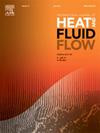多孔翅片相变储热换热器强化传热数值研究
IF 2.6
3区 工程技术
Q2 ENGINEERING, MECHANICAL
International Journal of Heat and Fluid Flow
Pub Date : 2025-04-24
DOI:10.1016/j.ijheatfluidflow.2025.109861
引用次数: 0
摘要
加翅片是换热器强化换热的有效方法之一。然而,在换热器内部添加翅片也会阻碍流体流动,从而影响自然对流换热,特别是对于相变储热换热器。本研究涉及在相变蓄热换热器的内翅片上穿孔,以减少翅片对相变材料自然对流的阻碍。计算采用熔融凝固模型进行三维非定常模拟。在强化传热的数值模拟研究中,将8个均匀和不均匀嵌入8个纵向穿孔翅片的管式相变换热器中,仔细研究和比较了它们的强化传热性能。通过分析相变材料的液相比和总熔化时间来评价射孔直径和孔洞分布,从而最大限度地提高翅片传导和液体中自然对流换热的联合增强效果。结果表明,当与全尺寸翅片结合使用时,翅片穿孔可以有效地平衡翅片的导热系数和相变材料的自然对流。当孔距内管分别为6 mm和15 mm,轴向孔距小于10 mm,孔直径为0.86 mm时,强化传热效果最佳。在此基础上,与未穿孔的翅片相比,使用穿孔非均匀翅片可显著减少相变材料的总熔化时间45.3%,从而提高了相变换热器的效率。本文章由计算机程序翻译,如有差异,请以英文原文为准。
Numerical heat transfer enhancement study on phase change thermal energy storage exchanger with perforated fins
Addition of fins is one of effective methods for heat transfer enhancement in heat exchangers. However, adding fins inside the heat exchanger also impedes fluid flow, which in turn affects natural convection heat transfer, especially for phase change heat storage exchangers. This study involves perforating the internal fins of the phase change thermal storage heat exchanger to reduce the obstruction of fins to the natural convection of phase change materials. The computations, carried out using the melting and solidification model for three-dimensional unsteady simulations. In the numerical simulation study on heat transfer enhancement, eight longitudinal perforated fins are imbedded uniformly and non-uniformly in a tubular phase change heat exchanger and their heat transfer enhancement performance are carefully examined and compared. The perforation diameter and hole distributions are evaluated by analyzing liquid phase ratio of the phase change material and the total melting time, thereby maximizing the combined enhancement effect of fin conduction and natural convection heat transfer in the liquid. The results indicate that fin perforation can effectively balance the thermal conductivity of the fins with the natural convection of the phase change materials when combined with full-scale fins. The optimal heat transfer enhancement occurs when the distance between the two holes and the inner tube is 6 mm and 15 mm, respectively, with an axial hole spacing of less than 10 mm and a hole diameter of 0.86 mm. On this basis, the use of perforated non-uniform fins significantly reduced the total melting time of the phase change material by 45.3 % compared to fins without perforating, thereby improving the efficiency of the phase change heat exchanger.
求助全文
通过发布文献求助,成功后即可免费获取论文全文。
去求助
来源期刊

International Journal of Heat and Fluid Flow
工程技术-工程:机械
CiteScore
5.00
自引率
7.70%
发文量
131
审稿时长
33 days
期刊介绍:
The International Journal of Heat and Fluid Flow welcomes high-quality original contributions on experimental, computational, and physical aspects of convective heat transfer and fluid dynamics relevant to engineering or the environment, including multiphase and microscale flows.
Papers reporting the application of these disciplines to design and development, with emphasis on new technological fields, are also welcomed. Some of these new fields include microscale electronic and mechanical systems; medical and biological systems; and thermal and flow control in both the internal and external environment.
 求助内容:
求助内容: 应助结果提醒方式:
应助结果提醒方式:


